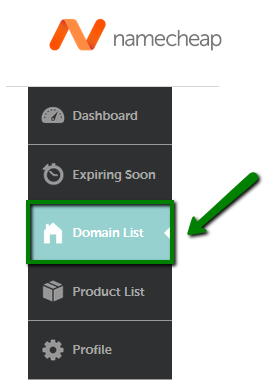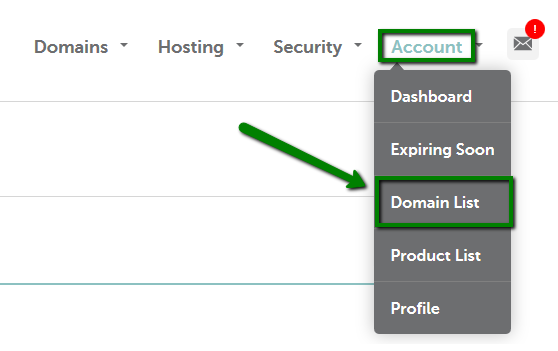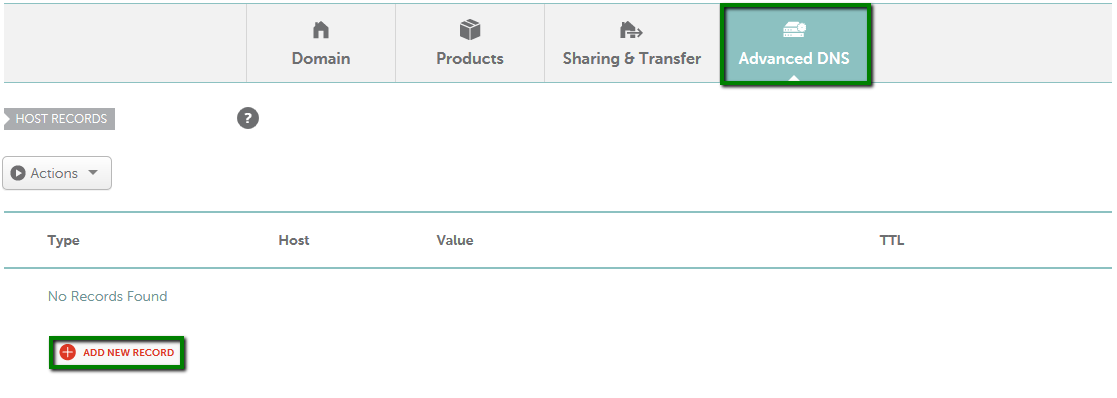| Subtotal | $0.00 |
| Subtotal | $0.00 |
To set up your host records for a domain that uses FreeDNS, follow the instructions given below:
1. Sign into your Namecheap account (The Sign In option is available in the header of the page).
2. Mouse over the Account option in the upper right corner of the page and choose Domain List or choose Domain List from the left sidebar:

3. Select All Products from the list at the right side of the page:
4. Click on the Manage option in front of the domain name:

5. Select Advanced DNS at the top of the page. Here you can add domain's host records (including A, CNAME, TXT, SRV, etc.), set up mail settings or enable/disable the Dynamic DNS feature:


Here is a brief description of all record types that can be added on our DNS servers:
|
Address Record Type
|
Description |
|
Allows you to associate a host with an IPv4 address. The IP address that you use does not have to be on your network. For example: You can have the host record for www pointed to 207.46.130.14 (Microsoft website's address). |
|
|
Allows you to associate a host with an IPv6 address. The IP address that you use does not have to be on your network.
For example:
You can have the host record for www pointed to 2001:0db8:11a3:09d7:1f34:8a2e:07a0:765d |
|
|
Allows you to specify the address of your mail server. When you use a mail record, you must use an IP address in the address field. Note to professional users: Creating a mail record creates both the MX and A records in DNS. Also, when using multiple mail servers, a preference value of 10 is used on all entries. |
|
|
C an be either a host name under your domain name (for example, "mail3") or the name of a mail server (for example, "mail.yahoo.com."). NOTE: When using a mail server name, it should end with a period ("."). (If you forget the period and we recognize the TLD, we will automatically insert one). |
|
|
Associates a host name with another host. The host that you wish to point to does not have to be on your network. For example: You can have the host record for www point to www.microsoft.com. You can also simply use the "@" sign to represent your domain. |
|
|
NS |
Primarily used if you want to break your domain into subdomains. Subdomains indicate you are delegating a portion of a domain name to a different group of nameservers, thus, creating NS records to point the hostname (name of the subdomain) to different nameservers. |
|
Standard method for URL Forwarding. When web users type in your domain name, they are redirected to the web server where your web pages are hosted on. The only drawback of this option is that the URL displayed by the browser is the one on the actual web page, not your domain name. You can overcome this drawback by using the URL Frame method instead. |
|
|
The URL Frame is similar to URL Redirect except that instead of redirecting the client to your web page, the web page is displayed in a frame from our web server. Using this option, the client's browser will display your domain name (for example, www.mydomain.com) while they are using your site and not the actual URL to your page (e.g., home.infospace.com/user33"). |
|
|
Wildcard record which is used to include any records or subdomains that you have not specified to catch any typos or mistakes. |
|
|
TXT record provides the ability to associate some text with a host or other name. This type of DNS record is usually used for SPF (Sender Policy Framework), DKIM (DomainKeys Identified E-mail) and DMARC (Domain-based Message Authentication, Reporting and Conformance) purposes. |
If you have any questions, feel free to contact our Support Team.
Need help? We're always here for you.